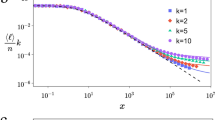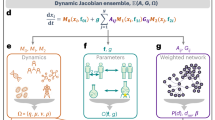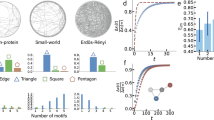Abstract
Complex systems must respond to external perturbations and, at the same time, internally distribute information to coordinate their components. Although networked backbones help with the latter, they limit the components’ individual degrees of freedom and reduce their collective dynamical range. Here we show that real-world networks balance the loss of response diversity with gain in information flow. Encoding network states as density matrices, we demonstrate that such a trade-off mathematically resembles the thermodynamic efficiency characterized by heat and work in physical systems, providing a variational principle to macroscopically explain the sparsity and empirical scaling law observed in hundreds of real-world networks across multiple domains, both analytically and numerically. We show that the emergence of topological features such as modularity, small-worldness and heterogeneity agrees with maximizing the trade-off between information exchange and response diversity from middle to large temporal scales. Our results suggest that the emergence of some of the most prevalent topological features of real-world networks might have a thermodynamic origin.
This is a preview of subscription content, access via your institution
Access options
Access Nature and 54 other Nature Portfolio journals
Get Nature+, our best-value online-access subscription
$29.99 / 30 days
cancel any time
Subscribe to this journal
Receive 12 print issues and online access
$209.00 per year
only $17.42 per issue
Buy this article
- Purchase on Springer Link
- Instant access to full article PDF
Prices may be subject to local taxes which are calculated during checkout





Similar content being viewed by others
Data availability
The data necessary to reproduce the results of this work are available in Supplementary Data 1.
Code availability
The code necessary to reproduce the results of this work is available in Supplementary Code 1.
References
Busiello, D. M., Suweis, S., Hidalgo, J. & Maritan, A. Explorability and the origin of network sparsity in living systems. Sci. Rep. 7, 12323 (2017).
Barabási, A.-L. & Albert, R. Emergence of scaling in random networks. Science 286, 509–512 (1999).
Watts, D. J. & Strogatz, S. H. Collective dynamics of ‘small-world’ networks. Nature 393, 440–442 (1998).
Newman, M. E. Modularity and community structure in networks. Proc. Natl Acad. Sci. USA 103, 8577–8582 (2006).
Ravasz, E. & Barabási, A.-L. Hierarchical organization in complex networks. Phys. Rev. E 67, 026112 (2003).
Tononi, G., Sporns, O. & Edelman, G. M. A measure for brain complexity: relating functional segregation and integration in the nervous system. Proc. Natl Acad. Sci. USA 91, 5033–5037 (1994).
Albert, R. & Barabási, A.-L. Topology of evolving networks: local events and universality. Phys. Rev. Lett. 85, 5234 (2000).
Krapivsky, P. L., Redner, S. & Leyvraz, F. Connectivity of growing random networks. Phys. Rev. Lett. 85, 4629 (2000).
Pacheco, J. M., Traulsen, A. & Nowak, M. A. Coevolution of strategy and structure in complex networks with dynamical linking. Phys. Rev. Lett. 97, 258103 (2006).
Garlaschelli, D., Capocci, A. & Caldarelli, G. Self-organized network evolution coupled to extremal dynamics. Nat. Phys. 3, 813–817 (2007).
Dorogovtsev, S. N. & Mendes, J. F. Evolution of networks. Adv. Phys. 51, 1079–1187 (2002).
Papadopoulos, F., Kitsak, M., Serrano, M. Á., Boguná, M. & Krioukov, D. Popularity versus similarity in growing networks. Nature 489, 537–540 (2012).
Molkenthin, N. & Timme, M. Scaling laws in spatial network formation. Phys. Rev. Lett. 117, 168301 (2016).
Caldarelli, G., Capocci, A., De Los Rios, P. & Munoz, M. A. Scale-free networks from varying vertex intrinsic fitness. Phys. Rev. Lett. 89, 258702 (2002).
Gallos, L. K., Havlin, S., Stanley, H. E. & Fefferman, N. H. Propinquity drives the emergence of network structure and density. Proc. Natl Acad. Sci. USA 116, 20360–20365 (2019).
Kolenbrander, P. E. et al. Communication among oral bacteria. Microbiol. Mol. Biol. Rev. 66, 486–505 (2002).
Leeder, A. C., Palma-Guerrero, J. & Glass, N. L. The social network: deciphering fungal language. Nat. Rev. Microbiol. 9, 440–451 (2011).
Faust, K. & Raes, J. Microbial interactions: from networks to models. Nat. Rev. Microbiol. 10, 538–550 (2012).
Vergassola, M., Villermaux, E. & Shraiman, B. I. ‘Infotaxis’ as a strategy for searching without gradients. Nature 445, 406–409 (2007).
Nicholson, S. B., García-Pintos, L. P., del Campo, A. & Green, J. R. Time–information uncertainty relations in thermodynamics. Nat. Phys. 16, 1211–1215 (2020).
Banavar, J. R., Maritan, A. & Rinaldo, A. Size and form in efficient transportation networks. Nature 399, 130–132 (1999).
Strogatz, S. H. Exploring complex networks. Nature 410, 268–276 (2001).
West, G. B. & Brown, J. H. Life’s universal scaling laws. Phys. Today 57, 36–42 (2004).
Barabási, A.-L. & Oltvai, Z. N. Network biology: understanding the cell’s functional organization. Nat. Rev. Genet. 5, 101–113 (2004).
West, G. B. & Brown, J. H. The origin of allometric scaling laws in biology from genomes to ecosystems: towards a quantitative unifying theory of biological structure and organization. J. Exp. Biol. 208, 1575–1592 (2005).
Marquet, P. A. et al. Scaling and power-laws in ecological systems. J. Exp. Biol. 208, 1749–1769 (2005).
Boccaletti, S., Latora, V., Moreno, Y., Chavez, M. & Hwang, D.-U. Complex networks: structure and dynamics. Phys. Rep. 424, 175–308 (2006).
Achard, S. & Bullmore, E. Efficiency and cost of economical brain functional networks. PLoS Comput. Biol. 3, e17 (2007).
Bullmore, E. & Sporns, O. The economy of brain network organization. Nat. Rev. Neurosci. 13, 336–349 (2012).
Rubinov, M., Ypma, R. J. F., Watson, C. & Bullmore, E. T. Wiring cost and topological participation of the mouse brain connectome. Proc. Natl Acad. Sci. USA 112, 10032–10037 (2015).
Bornholdt, S. & Sneppen, K. Robustness as an evolutionary principle. Proc. R. Soc. Lond. B 267, 2281–2286 (2000).
Kleinberg, J. M. Navigation in a small world. Nature 406, 845–845 (2000).
Tadi’c, B., Rodgers, G. J. & Thurner, S. Transport on complex networks: flow, jamming and optimization. Int. J. Bifurcat. Chaos 17, 2363–2385 (2007).
O’Kelly, M. E. A geographer’s analysis of hub-and-spoke networks. J. Transp. Geogr. 6, 171–186 (1998).
Barthélemy, M. Spatial networks. Phys. Rep. 499, 1–101 (2011).
Barzel, B. & Barabási, A.-L. Universality in network dynamics. Nat. Phys. 9, 673–681 (2013).
Harush, U. & Barzel, B. Dynamic patterns of information flow in complex networks. Nat. Commun. 8, 2181 (2017).
Hens, C., Harush, U., Haber, S., Cohen, R. & Barzel, B. Spatiotemporal signal propagation in complex networks. Nat. Phys. 15, 403–412 (2019).
Barrat, A., Barthelemy, M. & Vespignani, A. Dynamical Processes on Complex Networks (Cambridge Univ. Press, 2008).
Ghavasieh, A. & De Domenico, M. Generalized network density matrices for analysis of multiscale functional diversity. Phys. Rev. E 107, 044304 (2023).
Ghavasieh, A., Nicolini, C. & De Domenico, M. Statistical physics of complex information dynamics. Phys. Rev. E 102, 052304 (2020).
De Domenico, M. & Biamonte, J. Spectral entropies as information-theoretic tools for complex network comparison. Phys. Rev. X 6, 041062 (2016).
Ghavasieh, A., Bontorin, S., Artime, O., Verstraete, N. & De Domenico, M. Multiscale statistical physics of the pan-viral interactome unravels the systemic nature of SARS-CoV-2 infections. Commun. Phys. 4, 83 (2021).
Ghavasieh, A., Stella, M., Biamonte, J. & Domenico, M. D. Unraveling the effects of multiscale network entanglement on empirical systems. Commun. Phys. 4, 129 (2021).
Ghavasieh, A., Bertagnolli, G. & De Domenico, M. Dismantling the information flow in complex interconnected systems. Phys. Rev. Research 5, 013084 (2023).
Ghavasieh, A. & De Domenico, M. Enhancing transport properties in interconnected systems without altering their structure. Phys. Rev. Research 2, 013155 (2020).
Villegas, P., Gili, T., Caldarelli, G. & Gabrielli, A. Laplacian renormalization group for heterogeneous networks. Nat. Phys. 19, 445–450 (2023).
Peixoto, T. P. Nonparametric Bayesian inference of the microcanonical stochastic block model. Phys. Rev. E 95, 012317 (2017).
Clauset, A. The Colorado index of complex networks; https://icon.colorado.edu/#!/networks
Dixit, P. D. et al. Perspective: maximum caliber is a general variational principle for dynamical systems. J. Chem. Phys. 148, 010901 (2018).
Ghosh, K., Dixit, P. D., Agozzino, L. & Dill, K. A. The maximum caliber variational principle for nonequilibria. Annu. Rev. Phys. Chem.71, 213–238 (2020).
Gilbert, E. N. Random graphs. Ann. Math. Stat. 30, 1141–1144 (1959).
Fienberg, S. E. A brief history of statistical models for network analysis and open challenges. J. Comput. Graph. Stat. 21, 825–839 (2012).
DeLellis, P., Garofalo, F. & Liuzza, D. et al. Analysis and stability of consensus in networked control systems. Appl. Math. Comput. 217, 988–1000 (2010).
Hastings, A. Complex interactions between dispersal and dynamics: lessons from coupled logistic equations. Ecology 74, 1362–1372 (1993).
Steele, J. Human dispersals: mathematical models and the archaeological record. Human Biol. 81, 121–140 (2009).
Fisher, R. A. The wave of advance of advantageous genes. Ann. Eugen. 7, 355–369 (1937).
Belik, V., Geisel, T. & Brockmann, D. Natural human mobility patterns and spatial spread of infectious diseases. Phys. Rev. X 1, 011001 (2011).
Brockmann, D. & Helbing, D. The hidden geometry of complex, network-driven contagion phenomena. Science 342, 1337–1342 (2013).
Bontorin, S. & De Domenico, M. Multi pathways temporal distance unravels the hidden geometry of network-driven processes. Commun. Phys. 6, 129 (2023).
Boguna, M. et al. Network geometry. Nat. Rev. Phys. 3, 114–135 (2021).
Arenas, A., Díaz-Guilera, A., Kurths, J., Moreno, Y. & Zhou, C. Synchronization in complex networks. Phys. Rep. 469, 93–153 (2008).
De Domenico, M. Diffusion geometry unravels the emergence of functional clusters in collective phenomena. Phys. Rev. Lett. 118, 168301 (2017).
Lucas, M., Cencetti, G. & Battiston, F. Multiorder laplacian for synchronization in higher-order networks. Phys. Rev. Research 2, 033410 (2020).
Lee, S. H., Fricker, M. D. & Porter, M. A. Mesoscale analyses of fungal networks as an approach for quantifying phenotypic traits. J. Complex Networks 5, 145–159 (2017).
Nooner, K. B. et al. The NKI-Rockland sample: a model for accelerating the pace of discovery science in psychiatry. Front. Neurosci. 6, 152 (2012).
Szalkai, B., Kerepesi, C., Varga, B. & Grolmusz, V. Parameterizable consensus connectomes from the Human Connectome Project: the Budapest Reference Connectome Server v3.0. Cogn. Neurodynamics 11, 113–116 (2017).
Ryan, K., Lu, Z. & Meinertzhagen, I. A. The CNS connectome of a tadpole larva of Ciona intestinalis (L.) highlights sidedness in the brain of a chordate sibling. eLife 5, e16962 (2016).
Varshney, L. R., Chen, B. L., Paniagua, E., Hall, D. H. & Chklovskii, D. B. Structural properties of the Caenorhabditis elegans neuronal network. PLoS Comput. Biol. 7, e1001066 (2011).
Arnatkevičiūtė, A., Fulcher, B. D., Pocock, R. & Fornito, A. Hub connectivity, neuronal diversity, and gene expression in the Caenorhabditis elegans connectome. PLoS Comput. Biol. 14, e1005989 (2018).
Rossi, R. A. & Ahmed, N. K. The network data repository with interactive graph analytics and visualization. In Proc. AAAI Conference on Artificial Intelligence 29, 4292–4293 (2015).
Kim, H., Olave-Rojas, D., Álvarez-Miranda, E. & Son, S.-W. In-depth data on the network structure and hourly activity of the Central Chilean power grid. Sci. Data 5, 180209 (2018).
Blagus, N., Šubelj, L. & Bajec, M. Self-similar scaling of density in complex real-world networks. Phys. A: Stat. Mech. Appl. 391, 2794–2802 (2012).
Guimerà, R., Danon, L., Díaz-Guilera, A., Giralt, F. & Arenas, A. Self-similar community structure in a network of human interactions. Phys. Rev. E 68, 065103(R) (2003).
Sapiezynski, P., Stopczynski, A., Lassen, D. D. & Lehmann, S. Interaction data from the Copenhagen networks study. Sci. Data 6, 315 (2019).
Newman, M. E. J. Finding community structure in networks using the eigenvectors of matrices. Phys. Rev. E 74, 036104 (2006).
Dunne, J. A., Labandeira, C. C. & Williams, R. J. Highly resolved early Eocene food webs show development of modern trophic structure after the end-Cretaceous extinction. Proc. R. Soc. B 281, 20133280 (2014).
Martinez, N. D. Artifacts or attributes? Effects of resolution on the Little Rock Lake food web. Ecol. Monogr. 61, 367–392 (1991).
Knight, S., Nguyen, H. X., Falkner, N., Bowden, R. & Roughan, M. The Internet topology zoo. IEEE J. Sel. Areas Commun. 29, 1765–1775 (2011).
Crucitti, P., Latora, V. & Porta, S. Centrality measures in spatial networks of urban streets. Phys. Rev. E 73, 036125 (2006).
Acknowledgements
M.D.D. acknowledges partial financial support from the Human Frontier Science Program Organization (HFSP ref. RGY0064/2022), from the University of Padua (PRD-BIRD 2022) and from the EU funding within the MUR PNRR ‘National Center for HPC, BIG DATA AND QUANTUM COMPUTING’ (project no. CN00000013 CN1).
Author information
Authors and Affiliations
Contributions
A.G. and M.D.D. designed the study, performed the theoretical analysis and wrote the manuscript. A.G. performed the numerical experiments.
Corresponding authors
Ethics declarations
Competing interests
The authors declare no competing interests.
Peer review
Peer review information
Nature Physics thanks Baruch Barzel and Roger Guimerà for their contribution to the peer review of this work.
Additional information
Publisher’s note Springer Nature remains neutral with regard to jurisdictional claims in published maps and institutional affiliations.
Supplementary information
Supplementary Code 1
The necessary code to reproduce the results of this work.
Supplementary Data 1
Node and link numbers of the empirical networks relevant for the allometric scaling analysis.
Rights and permissions
Springer Nature or its licensor (e.g. a society or other partner) holds exclusive rights to this article under a publishing agreement with the author(s) or other rightsholder(s); author self-archiving of the accepted manuscript version of this article is solely governed by the terms of such publishing agreement and applicable law.
About this article
Cite this article
Ghavasieh, A., De Domenico, M. Diversity of information pathways drives sparsity in real-world networks. Nat. Phys. 20, 512–519 (2024). https://doi.org/10.1038/s41567-023-02330-x
Received:
Accepted:
Published:
Issue Date:
DOI: https://doi.org/10.1038/s41567-023-02330-x



